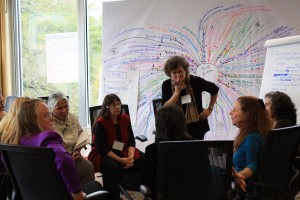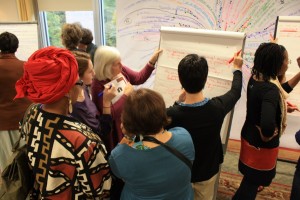April 14, 2014
Finding Common Ground: The Home Birth Consensus Summit
By: Sharon Muza, BS, LCCE, FACCE, CD/BDT(DONA), CLE | 0 Comments

© HBCS
http://homebirthsummit.org
While home birth has a proven safety record in countries outside the U.S., some attribute that to the fact that, in other countries, home birth takes place in the context of an integrated health care system. It is critical that all of the stakeholders in the maternal health care system are working together to ensure safe birth options in the U.S. as well.
The Home Birth Consensus Summit (HBCS) is a unique collaboration of all of the stakeholders currently involved in home birth in the United States. First held in 2011, the Home Birth Consensus Summit offers physicians, midwives, consumers, administrators and policy makers; (a varied group of representatives who do not often share common ground,) a chance to take a 360 degree look at the current maternal health care system and tease out the areas of conflict and common ground in order to increase safety in all birth settings.
Today on Science & Sensibility, our readers learn about the Home Birth Consensus Summit; its participants, purpose and process. Thursday, we will have the opportunity to review one of the groundbreaking products from the past two summits, when the HBCS releases the "Best Practice Guidelines: Transfer from Home Birth to Hospital" for consideration and adoption by maternal health organizations. Learn more about the HBCS from Summit Delegate Jeanette McCulloch as she interviews Saraswathi Vedam, RM FACNM MSN Sci D(hc), Home Birth Consensus Summit convener and chair. - Sharon Muza, Community Manager, Science & Sensibility
Jeanette McCulloch: What was the motivation behind launching the Home Birth Consensus Summit?
Saraswathi Vedam: Women want - and deserve - respectful, high quality maternity care regardless of their planned place of birth. Women and their families are not served by the interprofessional conflict and confusion that occurs in many regions in the US around place of birth.
While there may be points of disagreement, I know from numerous conversations with consumers, midwives, physicians, administrators, and policy makers that there are many more areas in maternity care where we all share a common set of principles and goals. Everyone is committed to working towards improved quality and safety for women and infants.
In 2011, a very intentionally selected group of stakeholders came together for the first Summit at the Airlie Center, in Warrenton, VA. These individuals represented all key leaders of the maternity care team, researchers, policy makers, payors, consumers, and consumer advocates. They came to the Summit with a wide variety of perspectives - including those for and against planned home birth. At the Summit, these delegates engaged in a unique process designed to help those with opposing viewpoints untangle complex issues. This process, called Future Search, guided the group through a complete exploration of every aspect of the maternal health care system. There were frank, challenging, and productive conversations, often among stakeholders who rarely, if ever, had been at the same table before. Once we were able to discover common ground, we were able to create a realistic and achievable strategic action plan together.
JM: Tell us about what common ground the Home Birth Consensus Summit has found so far.
SV: As the delegates discussed their shared responsibilities and vision for providing the best possible care, we realized that the vision applied to all birth settings. The nine common ground statements describe a maternity care environment that respects the woman's autonomy, ensuring she has safe access to qualified providers in all settings, and that the whole team that may care for her are well prepared with the clinical skills and knowledge that best applies to her specific situation. This will require attention to equity, cross-professional education, and research that includes the woman in defining the elements of "safety" and accurately describes the effects of birth place, or different models of care, on outcomes. The delegates shared a goal of increasing knowledge and access to physiologic birth, access to professional education and systems for quality monitoring for all types of midwives, from all communities; and reduction in barriers like cost and liability. Coming to this place of understanding and agreement, though, was only the beginning. Each of those action statements had to be turned into a concrete action plan that all of the stakeholders collaborated on developing.

© HBCS
http://homebirthsummit.org
JM: What is happening with the common ground statements now?
SV: Multi-disciplinary work groups have formed around each common ground statement. In 2013, the work groups came together for the second summit, again at the Airlie Center, to discuss progress made so far and tackle challenges.
Coming to this place of understanding and agreement, though, was only the beginning. The common ground statements are also encouraging a dialogue outside of our action groups that we could have never predicted. For example, the statements were read into the congressional record by Congresswoman Roybal-Allard, who said that the publication of the Home Birth Consensus document was "of critical importance to all current and future childbearing families in this country." In the following year, several of the Summit delegates were invited panelists and presenters at an Institute of Medicine Workshop on Research Issues in the Assessment of Birth Settings.
JM: What are some of the top outcomes of the work groups?
SV: One exciting outcome - a set of Best Practice Guidelines to provide optimal care for mothers and families transferring from home to hospital - will be released by the Home Birth Consensus Summit later this week. This project represents what the Summits are all about: bringing together stakeholders to look at every facet of an issue, and work together on concrete initiatives to improve outcomes. These guidelines are based on the best available research on effective interprofessional collaboration. Delegates who are leading midwives, physicians, nurses, policy makers and consumers from across the U.S. formed the Collaboration Task Force. They met regularly over eight months on weekends and after hours to research and carefully design a concrete evidence-based tool to improve quality and safety for women and increase respectful communication among providers. Easing the friction that can sometimes occur when families arrive at the hospital can not only increase safety for families, but also build trust and collaboration between providers.

© HBCS
http://homebirthsummit.org
Another group is collaborating to develop a Best Practice Regulation and Licensure Toolkit - a resource for state policy makers that will provide a best practice model of midwifery regulation to be used as a template to enact or improve licensure in a particular state.
Another important outcome is a study of midwives and mothers of color to better understand social and health care inequities that lead to higher incidence of prematurity and low birth weight.
JM: What comes next for the Summit?
SV: The action groups are continuing their work on initiatives in each of the common ground areas. At Summit III, scheduled for Fall 2014 in Seattle, WA, each action work group will share the products of their collaborations, and address some remaining priorities. These include research and data collection, ethics, and access to equitable care during pregnancy. We plan to expand the participants to include more leaders from policy and practice to disseminate the documents and engage more in this exciting work.
I have been working towards ensuring equitable birth options for women and their families for nearly 30 years. My goal for the Summits is to increase the probability that my four daughters - and everyone's daughters, wives, and sisters - will experience high quality, respectful maternity care.
What are your thoughts on the Home Birth Consensus Summits and this collaborative model? How do you see this further maternal infant health and safety. What would you like to see discussed by the stakeholders at Summit III in Seattle this fall? Let us know in the comments and join us on Thursday to learn more about the details of the soon to be released "Best Practice Guidelines: Transfer from Home Birth to Hospital."
Bios:
Saraswathi Vedam, RM FACNM MSN Sci D(hc), is the convener and chair of the Home Birth Consensus Summit. She has been active in setting national and international policy on home birth and midwifery education and regulation, providing expert consultations in Mexico, Hungary, Chile, China, Canada, and the United States. She serves as Senior Advisor to the MANA Division of Research, Chair of the ACNM Transfer Task Force, and Executive Board Member, Canadian Association of Midwifery Educators. Over the past 28 years she has cared for families in all birth settings. Professor Vedam's scholarly work includes critical appraisal of the literature on planned home birth, and development of the first US registry of home birth perinatal data. Contact Saraswathi Vedam.
Jeanette McCulloch, IBCLC, is the co-founder of BirthSwell an organization improving infant and maternal health by changing the way we talk about birth and breastfeeding. She has been using strategic communications and messaging to change policy, spread new ideas, and build thriving businesses for more than 20 years. Jeanette is honored to be working with local, national, and international birth and breastfeeding organizations (including the Home Birth Consensus Summit) and advocates ensuring that women have access to high-quality care and information.
Tags
Home Birth Maternity Care Labor/Birth Maternal Infant Care Jeanette McCulloch Home Birth Consensus Summit Saraswathi Vedam